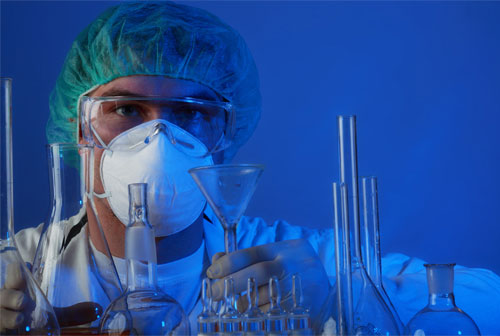Handling, Care, Cleaning & Drying Recommendation
Successful experimental results can only be achieved by using a clean apparatus. In all instances, Laboratory glassware must be physically clean, in nearly all cases it must be chemically clean and in specific cases, it must be bacteriologically clean or sterile. There must be no trace of grease and the safest criteria of cleanliness are the uniform wetting of the glass surface by distilled water. This being of the importance for all volumetric glassware. Any prevention of uniform Wetting of the surface will introduce errors such as distortion of the meniscus and accuracy of volume.

Handling of lab Glassware
- Always use process-specific PPE like cut-resistant gloves, full length lab coats/gowns, and a face shield/safety goggle etc.
- Inspect glassware for defects or cracks before use.
- Do not handle broken glass with bare hands. Use appropriate cut-resistant gloves to handle broken glass.
- Use forceps, tongs, scoops, or other mechanical devices for removing or retrieving broken glass from the work area or a fume hood.
- A dustpan and brush should be used to clean up shards/small pieces of broken glass, Pasteur pipettes, or shards of glass.
Below are some recommendations for the care & cleaning of Laboratory Glassware:
- We recommend that all glassware is washed before it is first used.
- Before using any piece of glassware, always take time to examine it carefully and ensure that it is in good condition.
- Cleaning of glassware that contains hazardous materials must be solely undertaken by experienced personnel.
- For precise chemical tests, new glassware should be soaked several hours in acid water (1% solution hydrochloride acid or nitric acid).
- Glassware, which is contaminated with blood Clots, culture media, etc. must be sterilized before cleaning.
- Wash the glassware as quickly as possible after use, but if delays are unavoidable, the Glassware should be allowed to soak in water.
- A pad of cotton or glass wool at the bottom of the jar will help to prevent breaking the tips of pipettes or burettes. Make sure that the water level is high enough to immerse the glassware completely. At a convenient time, the pipets may then be drained and placed in a cylinder or jar of dissolved detergent.
- Laboratory cleaner like alconox can also be used. a mild abrasive action can be applied, if the glassware is exceptionally dirty, provided the surface should not be scratched.
- If the Glassware becomes unduly cloudy or significantly dirty or contains coagulated organic matter it must be cleaned with chromic acid by soaking pipettes in a jar of chromic acid cleaning solution. The dichromats should be handle with extreme care because it is a powerful corrosive.
- After soaking for several hours, or overnight, drain the glassware and run tap water over and through them until all traces of dirt are removed.
- Soak the glassware in distilled water for at least an hour. Remove from the distilled water, rinse, dry the outside with a cloth, shake the water out.
Below are some recommendations for care & cleaning sintered glassware:
- New apparatus having sintered glass discs should be washed before use to remove loose particles of dust etc. Wash through with hot dilute hydrochloric acid followed by a thorough rinse with water.
- Do ensure that the porosity of the sintered disc is appropriate for the application. Porosity 0 sinters are for coarse filtration, whilst higher grades give progressively finer filtration.
- Never subject sintered glassware to differential pressures exceeding 1vf00kN/m2 (1 bar).
- Take extra care when heating sintered ware as the thermal endurance is less than standard borosilicate glass products. Always heat and cool very gradually.
- You may use a flask brush for cleaning lab glassware.
- It is recommended to use filter paper to easily collect the filtrate & for easy cleaning.
Autoclaving
The Volumetric glassware can be sterilized in an autoclave, as the accuracy of the volumetric glassware is not affected during a regular cycle (15 minutes at 121°C).
Drying
The volumetric glassware can be dry in baskets or on pegs in the air or in a hot air oven. Using a drying oven at 100°C is the most efficient way to remove all moisture from glassware. The drying temperature should not exceed 120°C.
If a drying oven is not convenient, use a rack/basket to dry the glassware. Ensure good air circulation by not overfilling the drying rack and that water runoff is easily drained away.
Disposal
Never dispose of contaminated glassware, including broken culture tubes and flasks, in a cardboard box. Broken glass from research laboratories must be discarded in a sharps container. Because of their special composition laboratory glassware has to be cleaned and then disposed of according to the current regulations.


















